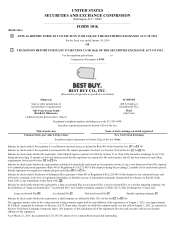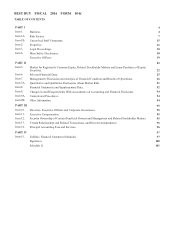Best Buy 2016 Annual Report Download - page 18
Download and view the complete annual report
Please find page 18 of the 2016 Best Buy annual report below. You can navigate through the pages in the report by either clicking on the pages listed below, or by using the keyword search tool below to find specific information within the annual report.10
• failure of third party companies to meet our standards or commitments;
• disruptions to our systems and implementation of new systems;
• limitations in capacity;
• consolidation or other changes in the distribution market;
• labor strikes or slow-downs impacting ports or any other aspect of our supply chain;
• damages or other loss to products; and
• costs that are excessive.
The risks associated with our dependence on third parties are greater for small parcel home deliveries, because of the relatively
small number of carriers with the scope and capacity required by our business. The aforementioned channel shift increases our
exposure to these risks. If we fail to manage these risks effectively, we could experience a material adverse impact on our
reputation, revenue and profitability.
If we fail to attract, retain and engage appropriately qualified employees, including employees in key positions, our
business and operating results may be harmed.
Our performance is highly dependent on attracting, retaining and engaging appropriately qualified employees, including our
executive team and other employees in key positions. Our strategy of offering high quality services and assistance for our
customers requires a highly trained and engaged workforce. The turnover rate in the retail industry is relatively high, and there
is an ongoing need to recruit and train new employees. Factors that affect our ability to maintain sufficient numbers of qualified
employees include employee morale, our reputation, unemployment rates, competition from other employers and our ability to
offer appropriate compensation packages. Failure to recruit or retain qualified employees in the future may impair our
efficiency and effectiveness and our ability to pursue growth opportunities. In addition, a significant amount of turnover of our
executive team or other employees in key positions with specific knowledge relating to us, our operations and our industry may
negatively impact our operations.
Demand for the products and services we sell could decline if we fail to maintain positive brand perception and
recognition.
We operate a portfolio of brands with a commitment to customer service and innovation. We believe that recognition and the
reputation of our brands are key to our success. The ubiquity of social media means that customer feedback and other
information about our company are shared with a broad audience in a manner that is easily accessible and rapidly disseminated.
Damage to the perception or reputation of our brands could result in declines in customer loyalty, decreases in gift card and
service plan sales, lower employee retention and productivity, vendor relationship issues and other factors, all of which could
materially affect our revenue and profitability.
Our success is dependent on the design and execution of appropriate business strategies.
We operate in a highly-competitive and ever-changing commercial environment. Our success is dependent on our ability to
identify, develop and execute appropriate strategies within this environment. Strategies that have proved successful in the past
may not be successful in the future. Our current strategy includes transformational change to certain areas of our business and
the pursuit of new growth opportunities. It is possible that our strategies may prove to be ineffective and that we may need to
make substantial changes to them in the future. It is also possible that we will be unsuccessful in executing our strategies or that
they expose us to additional risks. Our results could be materially adversely affected if we fail to develop and execute
appropriate strategies. The market value of our common stock and debt instruments could be materially adversely affected if
investors are uncertain about the appropriateness of our strategies or our ability to execute them.
Refer to Item 7, Management's Discussion and Analysis of Financial Condition and Results of Operations, for further
information regarding our strategies.
Failure to effectively manage our real estate portfolio may negatively impact our operating results.
Effective management of our real estate portfolio is critical to our omni-channel strategy. We primarily secure properties
through operating leases with third-party landlords. In light of the long-term nature of most of these commitments, it is
essential that we effectively evaluate a range of factors that may influence our long-term real estate strategy. Such factors
include, for example:
• changing patterns of customer consumption and behavior, particularly in light of an evolving omni-channel
environment;
























